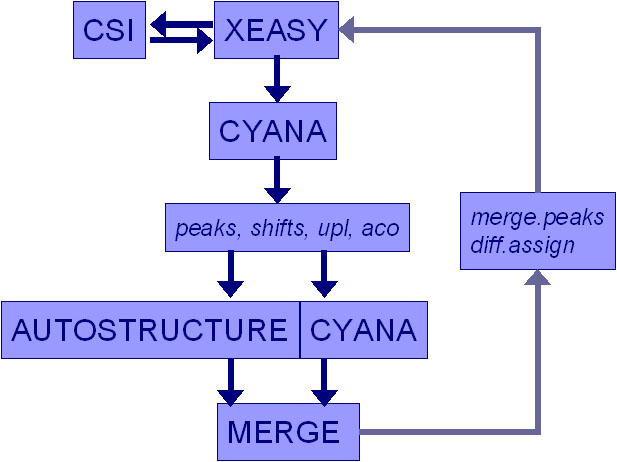Overview of Consensus Runs: Difference between revisions
No edit summary |
No edit summary |
||
| (4 intermediate revisions by the same user not shown) | |||
| Line 1: | Line 1: | ||
= ''' | == '''Introduction''' == | ||
AutoStructure and CYANA 2.1 are used in parallel to run automatic structure calculations. Identical NOE assignments from both programs (''consensus assignments'') are accepted as the starting point for the next structure calculation. This protocol provides a conservative way to obtain reliable long range NOE assignments in an automatic manner. The main goal of consensus run is to obtain many reliable NOE assignments rather than to deliver a structure. Consensus assignments should deliver a structure with RMSD < 2 A, which makes subsequent manual refinement straightforward.<br> | |||
[[Image:ConsensusMerge.jpg]] | |||
[[Image:ConsensusMerge.jpg]] | |||
Input data: | Input data: | ||
| Line 16: | Line 14: | ||
*intra- and short-range UPLs and ACOs | *intra- and short-range UPLs and ACOs | ||
Prior to consensus verify chemical shift and peak assignments. | Prior to a consensus run verify chemical shift and peak assignments. | ||
| | ||
| |||
== '''External Constraints''' == | == '''External Constraints''' == | ||
| Line 26: | Line 26: | ||
There is some controversy about the use of initial short and intra UPLs constraints in automatic NOE assignment.<br> The ''pro'' arguments: | There is some controversy about the use of initial short and intra UPLs constraints in automatic NOE assignment.<br> The ''pro'' arguments: | ||
*Intra and short peak assignments are carefully checked. | *Intra and short peak assignments are carefully checked. | ||
*Intra and short-range constraints are verified with [[FOUND|FOUND]] and [[ManualCYANARun|manual CYANA run]]. | *Intra and short-range constraints are verified with [[FOUND|FOUND]] and [[ManualCYANARun|manual CYANA run]]. | ||
*Intra and short-range peak assignments are preserved during structure calculation, thus preventing incorrect assignments for these peaks. | *Intra and short-range peak assignments are preserved during structure calculation, thus preventing incorrect assignments for these peaks. | ||
| Line 37: | Line 37: | ||
*CYANA 2.1 uses "elastic" NOE calibration, relaxing consistently violated UPLs. Incorrect external constraints essentially block this feature. | *CYANA 2.1 uses "elastic" NOE calibration, relaxing consistently violated UPLs. Incorrect external constraints essentially block this feature. | ||
To resolve these issues it may be suggested to run two automatic structure calculations, one with intra and short external constraints, and one without. The numbers of derived UPLs and the numbers of assigned/unassigned peaks can then be compared. | To resolve these issues it may be suggested to run two automatic structure calculations, one with intra and short external constraints, and one without. The numbers of derived UPLs and the numbers of assigned/unassigned peaks can then be compared. | ||
== '''Stereospecific | == '''Stereospecific Assignments''' == | ||
It is recommended to use [[NESG:SSAFromFractional13CLabeledSample|stereospecific assignments of Val and Leu methyl groups]] in automated structure calculation. | It is recommended to use [[NESG:SSAFromFractional13CLabeledSample|stereospecific assignments of Val and Leu methyl groups]] in automated structure calculation. | ||
Stereospecific assignments derived with [[FOUND|FOUND]] should be applied with caution at this stage, because the may not be 100% correct. | Stereospecific assignments derived with [[FOUND|FOUND]] should be applied with caution at this stage, because the may not be 100% correct. | ||
Latest revision as of 21:11, 6 January 2010
Introduction
AutoStructure and CYANA 2.1 are used in parallel to run automatic structure calculations. Identical NOE assignments from both programs (consensus assignments) are accepted as the starting point for the next structure calculation. This protocol provides a conservative way to obtain reliable long range NOE assignments in an automatic manner. The main goal of consensus run is to obtain many reliable NOE assignments rather than to deliver a structure. Consensus assignments should deliver a structure with RMSD < 2 A, which makes subsequent manual refinement straightforward.
Input data:
- protein sequence
- assigned chemical shifts
- integrated NOESY peaklists
- stereospecific assignments (recommended)
- TALOS ACOs
- intra- and short-range UPLs and ACOs
Prior to a consensus run verify chemical shift and peak assignments.
External Constraints
External constraints, such as TALOS dihedral angle constraints, are used to facilitate convergence to the correct structure.
There is some controversy about the use of initial short and intra UPLs constraints in automatic NOE assignment.
The pro arguments:
- Intra and short peak assignments are carefully checked.
- Intra and short-range constraints are verified with FOUND and manual CYANA run.
- Intra and short-range peak assignments are preserved during structure calculation, thus preventing incorrect assignments for these peaks.
- Improved convergence to the correct structure.
The contra arguments:
- Intra and short peaks frequently overlap with long-range peaks or the water line. Since the presence of long-range correlation is not known it may lead to overestimated peak integrals and too tight UPLs.
- Some too tight UPLs may still be overlooked during verification with FOUND and manual CYANA run.
- CYANA 2.1 uses "elastic" NOE calibration, relaxing consistently violated UPLs. Incorrect external constraints essentially block this feature.
To resolve these issues it may be suggested to run two automatic structure calculations, one with intra and short external constraints, and one without. The numbers of derived UPLs and the numbers of assigned/unassigned peaks can then be compared.
Stereospecific Assignments
It is recommended to use stereospecific assignments of Val and Leu methyl groups in automated structure calculation.
Stereospecific assignments derived with FOUND should be applied with caution at this stage, because the may not be 100% correct.
